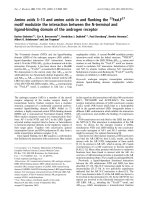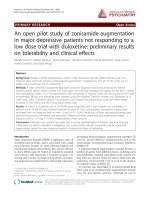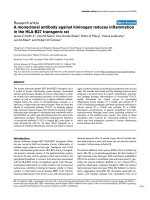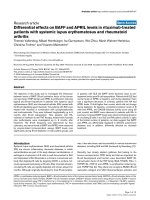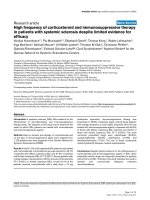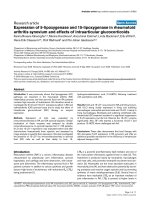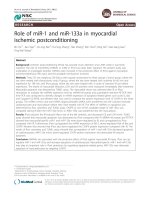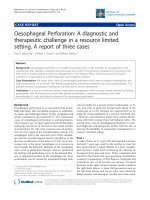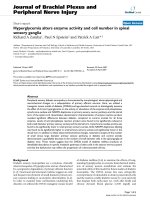Báo cáo y học: " Dietary intake, lung function and airway inflammation in Mexico City school children exposed to air pollutants" doc
Bạn đang xem bản rút gọn của tài liệu. Xem và tải ngay bản đầy đủ của tài liệu tại đây (325.03 KB, 12 trang )
BioMed Central
Page 1 of 12
(page number not for citation purposes)
Respiratory Research
Open Access
Research
Dietary intake, lung function and airway inflammation in Mexico
City school children exposed to air pollutants
Isabelle Romieu*
1
, Albino Barraza-Villarreal
1
, Consuelo Escamilla-Núñez
1
,
Jose L Texcalac-Sangrador
1
, Leticia Hernandez-Cadena
1
, David Díaz-
Sánchez
2
, Jordi De Batlle
3,4
and Blanca E Del Rio-Navarro
5
Address:
1
Instituto Nacional de Salud Pública, Cuernavaca, Mexico,
2
Human Studies Division, United States Environmental Protection Agency,
Chapel Hill, North Carolina, USA,
3
Centre for Research in Environmental Epidemiology (CREAL), Barcelona, Spain,
4
CIBER Epidemiología y
Salud Pública (CIBERESP), Barcelona, Spain and
5
Hospital Infantil de México Federico Gómez, Mexico, DF, Mexico
Email: Isabelle Romieu* - ; Albino Barraza-Villarreal - ; Consuelo Escamilla-
Núñez - ; Jose L Texcalac-Sangrador - ; Leticia Hernandez-
Cadena - ; David Díaz-Sánchez - ; Jordi De Batlle - ;
Blanca E Del Rio-Navarro -
* Corresponding author
Abstract
Introduction: Air pollutant exposure has been associated with an increase in inflammatory
markers and a decline in lung function in asthmatic children. Several studies suggest that dietary
intake of fruits and vegetables might modify the adverse effect of air pollutants.
Methods: A total of 158 asthmatic children recruited at the Children's Hospital of Mexico and 50
non-asthmatic children were followed for 22 weeks. Pulmonary function was measured and nasal
lavage collected and analyzed every 2 weeks. Dietary intake was evaluated using a 108-item food
frequency questionnaire and a fruit and vegetable index (FVI) and a Mediterranean diet index (MDI)
were constructed. The impact of these indices on lung function and interleukin-8 (IL-8) and their
interaction with air pollutants were determined using mixed regression models with random
intercept and random slope.
Results: FVI was inversely related to IL-8 levels in nasal lavage (p < 0.02) with a significant inverse
trend (test for trend p < 0.001), MDI was positively related to lung function (p < 0.05), and children
in the highest category of MDI had a higher FEV
1
(test for trend p < 0.12) and FVC (test for trend
p < 0.06) than children in the lowest category. A significant interaction was observed between FVI
and ozone for FEV
1
and FVC as was with MDI and ozone for FVC. No effect of diet was observed
among healthy children.
Conclusion: Our results suggest that fruit and vegetable intake and close adherence to the
Mediterranean diet have a beneficial effect on inflammatory response and lung function in asthmatic
children living in Mexico City.
Published: 10 December 2009
Respiratory Research 2009, 10:122 doi:10.1186/1465-9921-10-122
Received: 25 May 2009
Accepted: 10 December 2009
This article is available from: />© 2009 Romieu et al; licensee BioMed Central Ltd.
This is an Open Access article distributed under the terms of the Creative Commons Attribution License ( />),
which permits unrestricted use, distribution, and reproduction in any medium, provided the original work is properly cited.
Respiratory Research 2009, 10:122 />Page 2 of 12
(page number not for citation purposes)
Introduction
Exposure to air pollution has been associated with decre-
ments in lung function [1-3] and an increase in respira-
tory symptoms [4], effects to which asthmatic children
appear more susceptible [5,6]. We have recently shown
that exposure to fine particles (PM
2.5
) and ozone (O
3
)
results in acute airway inflammation and a decrease in
lung function in both asthmatic and non-asthmatic chil-
dren [7]. In a randomized controlled trial among asth-
matic children, we also showed that antioxidant
supplementation (vitamin C and E) modulates the
adverse effect of O
3
on lung function and inflammatory
response [8]. Fruits and vegetables are rich in antioxi-
dants, in particular vitamin C and carotenoids, and higher
intake has been related to better lung function in both
adults [9] and children [10]. The Mediterranean diet has
been shown to have a high antioxidant potential [11] and
a beneficial effect on the risk of rhinitis [12] and asthma
[13] in children and on lung function in adults[9]. In this
study, we evaluated the impact and the potential modu-
lating effect of dietary intake on lung function and airway
inflammation among Mexico City school children
exposed to high levels of air pollutants.
Materials and methods
Study design
A dynamic panel (cohort) study of 6 to 14 year-old asth-
matic and non-asthmatic school children living in Mexico
City was conducted between June 2003 and June 2005.
The asthmatic children (n = 158) were patients of the Fed-
erico Gomez Hospital Infantil de Mexico. The severity of
diagnosis of their asthma was based on clinical symptoms
and response to treatment and rated by a pediatric aller-
gist as mild (intermittent or persistent), moderate or
severe according to Global Initiative for Asthma (GINA)
guidelines [14]. Fifty non-asthmatic children were
recruited by asking the asthmatic children to invite a
schoolmate or a friend from their neighborhood; dropped
out early after recruitment (9%). The children were
enrolled during the first 10 months of the study (June
2003 - April 2004) and followed for an average of 22
weeks. Spirometric tests, measurements of interleukin-8
(IL-8) levels in nasal lavage and anthropometry measure-
ments were conducted every 2 weeks during follow-up.
The study methodology has been described elsewhere [7].
All procedures were explained to the parents, who signed
an informed consent form. The children also gave their
informed consent. The study protocol was reviewed and
approved by the ethics committees at both the National
Institute of Public Health and the Hospital Infantil de
Mexico.
We collected data on sociodemographic variables includ-
ing mother and father education, the type of school
attended by the child, past health history and potential
indoor environmental exposures. Allergy test results and
information on medication and medical visits over the
previous 2 years were obtained from the medical record.
Spirometry
The spirometric tests were performed according to Ameri-
can Thoracic Society (ATS) specifications [15] using an
EasyOne spirometer providing age, gender and height
standardized pulmonary functions (ndd Medical Tech-
nologies, Andover, MA, USA). All lung function tests were
performed by the same technicians, and the best of three
technically acceptable tests was selected. Prior to the
spirometric test, children answered a questionnaire on
respiratory symptoms and had a clinical exam. If a child
was diagnosed with respiratory infections, the spirometry
was not done that day and was rescheduled for another
day.
Nasal lavage
Nasal lavage was performed following the methodology
proposed by Diaz-Sanchez et al. [16], with the children
sitting with the nasopharynx closed while tilting their
neck back 45 from vertical. Five ml of warm (37°C) nor-
mal saline is instilled into each nostril by pipette. After 10
seconds, during which the subject shakes their head softly
from side to side, they bring their head forward, expelling
the wash fluid into a plastic receptable. The subject then
performs up to four further nasal washes at 30-second
intervals, with each wash being collected in a separate
tube. We measured different cytokines including IL8,
interferon gamma, IL6 and IL10 levels in nasal lavage in
the laboratory of Dr. Diaz-Sanchez, using commercially
available Elisa kits according to the manufacturer's
instructions. However, except for IL8, the levels in most of
the samples were under the detection limit and we report
only the IL8 results. For logistic reasons, we did not deter-
mine cellular composition.
Exhaled Nitric Oxide Levels
The levels of FeNO were measured following the ATS
guidelines [17] during outpatient visits to a clinic. Chil-
dren were seated for at least 5 min before commencing the
measurement and throughout the procedure; all measure-
ments were conducted indoors to minimize external
inhaled NO-free external air. NO was measured by chemi-
luminescence, using a continuous analyzer (CDL 88 sq
Michigan, USA). The FeNO reading was displayed in the
monitoring system and the mean of the three acceptable
tests was taken.
Exhaled Breath Condensate Collection
EBC was collected using an R-tube and the breath was
cooled by placing an aluminum cooling sleeve over the
disposable polypropylene tube [18]. Samples were
Respiratory Research 2009, 10:122 />Page 3 of 12
(page number not for citation purposes)
obtained following the ATS/ERS Task Force recommenda-
tions [18,19]. Participants were asked to breathe tidally
through the mouthpiece connected to the R-tube for 10
minutes to collect approx. 2 ml of exhaled breath fluid,
which was aliquoted and frozen to -70 C within 15 min-
utes of collection.
Dietary assessment
At baseline, the mothers completed a 108-item food fre-
quency questionnaire. A commonly used unit or portion
size was specified for each food item (slice, glass, or natu-
ral unit such as one apple) and each mother was asked
how often, on average, her child had consumed that
amount over the previous year. Eight possible responses
were given: 4 or more times per day; 2-3 times per day;
once per day; 5-6 times per week; 2-4 times per week; once
per week; 1-3 times per month, and; never or less than
once per month [20]. We assigned proportional weight to
each frequency of consumption in order to obtain a daily
intake for all items provided in the food frequency ques-
tionnaire. The following weights were assigned: never or
less than once per month = 0, 1-3 times per month = 2/30,
once per week = 1/7, 2-4 times per week = 3/7, 5-6 times
per week = 5.5/7, once per day = 1, 2-3 times per day = 2.5
and 4 or more times per day = 4.
The questionnaire was adapted to the Mexican population
from the one developed by Willett et al. and validated in
this population [20-22]. This dietary information was
used to calculate the daily consumption of 8 food groups:
fruits, vegetables, cereals, legumes, dairy products, meat,
fish and junk food.
From these groups, two food consumption indices were
constructed: a fruit and vegetable index (FVI) and a Med-
iterranean diet index (MDI). 1) The FVI was based on the
intake of fruits and vegetables and the consumption of
vitamins or supplements reported on the questionnaire
and were scored on a scale of 0 to 3. Children whose con-
sumption was below the median value were assigned 0,
while children whose consumption was at or above of the
median value were assigned 1. Additionally, the score was
increased by 1 if the child reported consumption of vita-
min C or supplement. This index was used as a continu-
ous variable and a categorical variable considering 4
groups (0,1,2,3). 2) The MDI was adapted from that
designed by Trichopoulou [23] and was generated from
the sum of the 8 food groups to evaluate adherence to the
Mediterranean dietary pattern. This index was generated
as follows: i) The moderate alcohol consumptions com-
ponent was suppressed as it was not applicable to chil-
dren: ii) The high monounsaturated/saturated
consumptions were eliminated because fat ratio compo-
nent as it could not be computed from the available data:
iii) And a junk food component was introduced as a pre-
vious study had suggested including fast food, snacks and
sweets in Mediterranean diet scores [24]. In the case of
fruits, vegetables, cereals, legumes, dairy products and
fish, a value of 1 was assigned if consumption was above
of the median value and 0 otherwise. For meat and junk
food, the scoring was reversed. The scores for each food
group were then summed to obtain a total score ranging
from 1 (minimum adherence) to 4 (maximum adher-
ence). This score was used a continuous variable and a cat-
egorical variable regrouping the score in four categories
(category 1 = score 1 to 3, category 2 = score 2, category 3
= score 3, category 4 = score 6 to 8).
Air pollutant exposure assessment
Exposure was estimated from the concentrations of out-
door fine particles (PM
2.5
), nitrogen dioxide (NO
2
) and
ozone (O
3
) recorded by the Mexico City government at
four fixed-site central monitoring (RAMA) locations in the
study area. Daily average, maximum moving average and
8-hour maximum concentrations and meteorological
data (temperature and humidity) were obtained for all
505 days of the study period. The home of each child was
geo-referenced using a geographic information system
and the closest monitoring station was assigned to the
child. All children attended public schools located close to
their home and no fixed-site monitoring station was more
than 5 km from a child's home or school.
Statistical analysis
The basic characteristics of the two groups of children
were compared by bivariate analysis using the t-test, the
Fisher exact test or the
χ
2
test, depending on variable type.
The associations between diet indices and health out-
comes were evaluated using linear mixed effects models
with random intercept, considering models for continu-
ous response. These models account for repeated meas-
urements in the same individuals enabled us to appreciate
the variability within and between subjects.
The model is as follows:
Where; i: represents the observation in the subject i. Y
j
,
corresponds to the dependent variables, X
i
are the inde-
pendent variables with fixed effects and
ε
i
vector of resid-
ual components. A further advantage of the models used
is that they do not discard subjects with incomplete data
and take into account the correlation among repeated
measurements in the same individual. The goodness of fit
of each model was determined using residual diagnosis
and the Hausman specification test [25]. Data on O
3
,
PM
2.5
and NO
2
was included in our regression models on
the basis of a previous analysis of these pollutants [7],
which are known to affect pulmonary function and
YX b
ii iii
=++
βε
Z
(1)
Respiratory Research 2009, 10:122 />Page 4 of 12
(page number not for citation purposes)
inflammatory markers. Models were adjusted for poten-
tial confounding, including gender, body mass index, pre-
vious day minimum temperature, corticoid use and
chronological time. Other variables such as age, socioeco-
nomic index (based on maternal education and school
type), outdoor activities, atopic status, exposure to envi-
ronmental tobacco smoke, use of anti-allergy medicine
and season were not significant (p > 0.10) and did not
alter the results by >1%. We also tested for interaction
between air pollutant exposure and dietary intake to
assess any modifying effect of diet on the adverse effect of
air pollution on lung health including interaction term in
our models and also evaluating the effect of our nutri-
tional indices in children exposed to low and high levels
of pollutants. We calculated the percent of change in IL-8
and pulmonary function in relation with FVI and MDI
using the coefficients from our regression models divided
by the corresponding baseline characteristics. Analyses
were conducted using STATA 9.2 (Stata Corp., College Sta-
tion, Tx, USA).
Results
Table 1 presents the characteristics of the study popula-
tion. The median age of participants was 9.6 years
(Q25:7.9, Q75:11.0) for the asthmatic children and 9.3
(Q25:7.9, Q75:11.5) for the non-asthmatic children.
Fifty-five percent of the asthmatic children were classified
as having mild intermittent, 26.9% as having mild persist-
ent and 17.5% as having moderate persistent asthma
according to GINA guidelines. Eighty-nine percent of the
asthmatic children and 72% of the non-asthmatic chil-
dren had positive skin prick tests. The most common
allergens sensitivities appear in the table 1.
Dietary intake
Table 2 presents the daily dietary intake of the children by
food group and frequencies. There was no significant dif-
ference between the asthmatic and the nonasthmatic chil-
dren. We observed a high frequency of intake of fruit or
fruit juices, vegetables and dairy products as well as junk
food. The most frequently consumed fruits were oranges,
mandarins, apples, grapes, mangoes and grapefruits. Sixty
nine percent of the asthmatic children and 70.9% of the
non-asthmatic children were reported as consuming two
or more vegetables per day. The most frequently con-
sumed vegetables were tomatoes, zucchinis and chili pep-
pers. The intake of junk food was also high in both
groups, while the intake of fish was low. A total of 64.8%
of the asthmatic children and 76.4% of the non-asthmatic
children were reported as consuming two or more junk
Table 1: Baseline characteristics of the study population: 158 asthmatic and 50 non-asthmatic children living in Mexico City, 2003-2005
Asthmatic (n = 158) Non-asthmatic (n = 50)
Characteristics Median
§
(Q25, Q75) Median (Q25, Q75)
Sex, % masculine 61.9 40.0
Age, years 9.6 (7.9, 11.0) 9.3 (7.9, 11.5)
Weight, kg 36.0 (27.0, 46.0) 32.0 (26.0, 45.0)
Height, cm 137.0 (124.5, 147.0) 134.0 (127.0, 147.0)
BMI, Kg/m
2
18.9 (16.3, 22.0) 18.1 (15.7, 21.5)
Maternal education, years (mean (SD)) 9.8 (3.0) 9.3 (3.0)
Smoking at home, %
Father 54.8 45.0
Mother 41.1 28.6
Other person 23.4 29.1
Allergy prink test positive (Atopics) (%) 88.8 80.0
Main allergens testing (%)
Cat 28.1 27.3
Dog 20.0 21.8
House dust mite 61.9 45.4
Cockroach 41.9 30.9
Asthma diagnosis, %
Moderate persistent 17.5
Mild persistent 26.9
Mild intermittent 55.0
Baseline lung function and IL-8 levels
FEV
1
, L (mean (SD)) 1.9 (0.7) 1.95 (0.6)
FVC, L (mean (SD)) 2.3 (0.8) 2.25 (0.7)
IL-8, pg/ml
§
157.2 (78.2, 295.1) 202.9 (112.9, 333.6)
SD: Standard deviation
§
Mann-Whitney test [median (Q25, Q75)]
Respiratory Research 2009, 10:122 />Page 5 of 12
(page number not for citation purposes)
foods per day. Vitamin supplementation (mostly vitamin
C) was high in both groups. No difference in diet index
(FVI or MDI) scores was observed between the two
groups.
Air pollution exposure data
The 8-hour moving average PM
2.5
ranged from 4.24 to
102.8 μg/m
3
during the study period, with a mean of 28.9
μg/m
3
. It exceeded 30 μg/m
3
on 52% of the days. The 8-
hour moving average of NO
2
ranged from 14.9 to 77.6
ppb, with a mean of 37.4 ppb. The 8-hour moving average
of O
3
ranged from 4.9 to 86.3 ppb, with a mean of 31.6
ppb (Table 2). The correlation between PM
2.5
and O
3
was
r = 0.46 (p = 0.000). The correlations between O
3
and
NO
2
and NO
2
and PM
2.5
were r = 0.28 (p = 0.000) and r =
0.61 (p = 0.000), respectively. Local measurements con-
ducted at the children's schools were correlated with con-
centrations at the central monitoring stations (r = 0.77 for
PM
2.5
, r = 0.21 for NO
2
and r = 0.60 for O
3
). Mean local
measurements were 26.3 μg/m
3
(standard deviation (SD)
Table 2: Dietary intake frequency for specifics food group and diet index scores among 208 children living in Mexico City, 2003-2005
Characteristics Asthmatic (n = 158) Non-asthmatic (n = 50)
Fruit or fruit juice (%)
At least 4 times a month 4.4 1.8
2-6 times per week 34.2 23.6
More than once per day 61.4 74.6
Vegetables (%)
At least 4 times a month 1.9 1.8
2-6 times per week 28.3 27.3
More than once per day 69.8 70.9
Cereals or grains (%)
At least 4 times a month 0.6 0.0
2-6 times per week 21.4 20.0
More than once per day 78.0 80.0
Legumes (%)
At least 4 times a month 28.9 38.2
2-6 times per week 50.9 50.9
More than once per day 20.1 10.9
Dairy products (%)
At least 4 times a month 1.3 0.0
2-6 times per week 8.8 12.7
More than once per day 89.9 87.3
Meat
At least 4 times a month (%) 6.9 10.9
2-6 times per week (%) 76.1 76.4
More than once per day (%) 17.0 12.7
Fish (%)
At least 4 times a month 76.7 74.6
2-6 times per week 22.6 23.6
More than once per day 0.6 1.8
Junk food (%)
At least 4 times a month 0.6 1.8
2-6 times per week 34.6 21.8
More than once per day 64.8 76.4
Calories, kcal
(median (Q25, Q75))
§
1797.4(1594.9, 2194.4) 1795.2(1569.6, 2311.9)
Vitamins (%) 54.4 56.4
Fruit and vegetable index (%)
0 14.4 14.5
1 33.1 25.4
2 36.2 43.6
3 16.2 16.4
Mediterranean diet index (%)
1 37.5 41.8
2 18.1 25.4
3 23.7 16.4
4 20.6 16.4
§
Mann-Whitney test [median (Q25, Q75)]
Respiratory Research 2009, 10:122 />Page 6 of 12
(page number not for citation purposes)
= 12.5) for PM
2.5
, 35.05 ppb (SD = 12.6) for NO
2
and 26.9
ppb (SD = 9.5) for O
3
.
Association of FVI with lung function and IL-8
The associations between FVI and main outcomes for the
asthmatic and nonasthmatic children are shown in Table
3. After accounting for air pollutants (ozone and PM
2.5
)
and confounding factors, FVI was significantly related to
lower IL-8 and positively related to lung function. For
each 1-unit increase in FVI there was a significant decrease
in IL-8. We calculate that children in the highest intake
level of the FVI index (4) had 8% lower IL8 than children
with the lowest intake. FVI was not significantly related to
exhaled NO but we observed a positive association with
exhaled breath PH, although non-significant.
FVI was also positively related to forced expiratory volume
in one second (FEV
1
) and forced vital capacity (FVC). The
effect was marginally significant for FVC. A 1-point
increase in FVI was associated with a 105 ml (nearly 5%)
increase in FVC.
When FVI was analyzed as a categorical variable, we
observed a significant decreasing trend in IL-8 levels with
increasing categories of FVI (p = 0.001) but no clear trend
was observed for lung function (Figure 1).
We observed a significant positive interaction between
ozone level and FVI for both FEV
1
(p = 0.023) and FVC (p
= 0.008) suggesting that the protective effect of FVI
increased with higher ozone levels (Figure 2). When data
were stratified by low (≤ 25 ppb, max 8-h moving average)
and high (≥ 38 ppb, max 8-h moving average) ozone lev-
els, we observed that the positive effect of FVI was signifi-
cantly larger when exposure to ozone was in the highest
quartile. (Table 4)
Among non-asthmatic children, FVI was inversely related
to IL-8 but this association was not significant. FVI was
significantly related to an increase of exhaled NO. No
association with lung functions was observed.
Association of MDI with IL-8 and lung functions
The associations between MDI and main outcomes for the
asthmatic children are shown in Table 3. After accounting
for air pollutants (O
3
, PM
2.5
) and confounding factors,
including use of vitamin supplementation, MDI was not
related to IL-8 or to exhaled NO or exhaled breath PH.
However, it was significantly related to FEV
1
and to FVC.
Table 3: Association of inflammatory markers and lung function in school children living in Mexico City with exposure to Fruit and
vegetable index and Mediterranean diet index, 2003-2005
Fruit and vegetable index Mediterranean diet index
Models Coefficient* (SE) P value P value
&
Coefficient* (SE) P value P value
&
Asthmatic
Inflammatory markers
†
ln IL-8 -0.136(0.055) 0.013 -0.029(0.032) 0.358
lnFeNO -0.021(0.086) 0.812 -0.023(0.050) 0.649
pH 0.035(0.026) 0.179 -0.009(0.015) 0.546
Lung function
‡
FEV
1
(L) 0.074(0.053) 0.165 0.023 0.058(0.029) 0.045
FVC (L) 0.105(0.058) 0.073 0.008 0.075(0.032) 0.018 0.020
FEF25-75 (L) 0.048(0.078) 0.539 0.050(0.043) 0.241
Non-asthmatic
Inflammatory markers
†
ln IL-8 -0.133(0.107) 0.214 0.063(0.063) 0.312
lnFeNO 0.373(0.178) 0.036 0.154(0.115) 0.181
pH 0.041(0.052) 0.434 -0.015(0.030) 0.623
Lung function
‡
FEV
1
(L) -0.030(0.074) 0.689 -0.016(0.047) 0.730
FVC (L) 0.005(0.081) 0.952 -0.025(0.052) 0.622
FEF25-75 (L) -0.131(0.129) 0.309 0.047(0.080) 0.557
* Coefficients correspond to a change in the ln IL-8, LnFeno, pH or lung function for a change in one unit of the FVI or MDI.
†
Models for inflammatory markers included 753 inflammatory marker measurements for 119 asthmatic children. Models are adjusted for the
following variables: same day exposure: 24-hr average O
3
(pbb), 24-hr average PM
2.5
(μg/m
3
), previous day minimum temperature, gender, body
mass index, calories, corticoid use and chronological time.
‡
Models for lung function included 1503 lung function measurements for 158 asthmatic children.
Models are adjusted for the following variables: 5-day accumulated moving average O
3
(ppb), 5-day accumulated average (maximum) PM
2.5
(μg/m
3
),
previous day minimum temperature, gender, body mass index, calories and chronological time.
&
p value of interaction between ozone and indices (FVI or MDI)
Respiratory Research 2009, 10:122 />Page 7 of 12
(page number not for citation purposes)
A 1-point increase in MDI was associated with a 58 ml
increase in FEV
1
and a 75 ml increase in FVC.
When MDI was used as a categorical variable, we observed
that FEV
1
and FVC were significantly higher in the highest
category when compare to the three lower categories (Fig-
ure 3). We calculate that children in the highest intake cat-
egory of the MDI index (4) had a 15.3% higher FEV
1
and
a 16.5% higher FVC than children with the lowest cate-
gory.
We observed a significant positive interaction between
ozone level and MDI for FVC (p = 0.02) suggesting as for
FVI, that the protective effect of MDI increased with
increasing levels of ozone. When data were stratified by
low (≤ 25 ppb, max 8-h moving average) and high ozone
(≥ 38 ppb, max 8-h moving average) levels, we observed
that the positive effect of MDI on FVC was significantly
larger when exposure to ozone was in the highest quartile
(Table 4).
Among non-asthmatic children, no significant association
was observed between inflammatory markers or lung
functions and MDI.
Discussion
In this prospective cohort study, we observed that a higher
intake of fruits and vegetables and close adherence to the
MDI had a protective effect on the lung health of asth-
matic children. This was observed over the range of 5-22
pulmonary function tests and repeated measurements of
IL-8 in nasal lavage. We found a significant interaction
between FVI and MDI and ozone exposure on IL-8 and
lung functions, suggesting that high intake of fruits and
vegetables and close adherence to the Mediterranean diet
could modulate the adverse effect of O
3
.
Association between ln [IL-8] and lung function in asthmatic children living in Mexico City by categories of fruit and vegetable index (FVI) 2003-2005Figure 1
Association between ln [IL-8] and lung function in asthmatic children living in Mexico City by categories of
fruit and vegetable index (FVI) 2003-2005. [ln IL-8] model was adjusted for gender, body mass index, calories, 24-hr aver-
age O3 (pbb), previous day minimum temperature, corticoid use and chronological time. Lung function models were adjusted
for gender, body mass index, calories, 5-day accumulated moving average O3 (ppb), previous day minimum temperature and
chronological time. Reference category 0.
-1.00
-0.80
-0.60
-0.40
-0.20
0.00
0.20
0.40
0.60
0.80
-1.00
-0.80
-0.60
-0.40
-0.20
0.00
0.20
0.40
0.60
0.80
ln[IL-8] (pg/ml)
FEV
1
or FVC (L)
ln[IL-8]
FEV1
FVC
123 123 231
FVI category
Respiratory Research 2009, 10:122 />Page 8 of 12
(page number not for citation purposes)
Cross-sectional studies have shown that vitamin C and
fruit intake are related to better lung function in adults
[9,26]. Only one study has reported a similar effect in chil-
dren [10]. Several studies have also suggested that specific
foods might have an impact on asthma and allergies. Veg-
etables [9,27,28], fruits [9,27-29], dairy products
[9,28,30,31] and fish [9,29,32,33] have been associated
with reduced asthma risk in children, whereas fast food
[34] and dietary fats [31] have been associated with an
increased risk. Because foods can interact with one
another, it has been suggested that dietary patterns
derived from cluster or factor analysis [35] or the use of
diet scores [35] are a useful approach for characterizing
the diet of individuals and providing nutritional recom-
mendations. Three recent studies have shown a positive
impact of adherence to the Mediterranean diet on rhinitis
[12] and asthma [13] in children. However, they were
subject to bias as they relied on respiratory symptoms
reported by parents, with no objective measurement of
lung function or inflammatory response. In addition,
none of these studies took into account exposure to ambi-
ent air pollution a strong risk factor for respiratory health
[36]. The present study, on the other hand, is a prospec-
tive study that evaluates the effect of dietary intake of
fruits and vegetables and close adherence to the Mediter-
ranean diet on inflammatory response and lung function
among asthmatic and non-asthmatic children, taking
exposure to air pollutants into account.
We used two types of indices, a fruit and vegetable index
and a Mediterranean diet index. Our models were
adjusted for total caloric intake as well as for potential
confounding factors including gender, body mass index
and the use of corticosteroids. While we observed an
adverse effect of O
3
and PM
2.5
on inflammatory response
and lung function as reported previously [7], the diet indi-
Interaction between fruits and vegetables index and ozone levels (Q1-Q4) for IL8, FEV
1
and FVCFigure 2
Interaction between fruits and vegetables index and ozone levels (Q1-Q4) for IL8, FEV
1
and FVC. Q1 = ≤ 25 ppb,
max 8-h moving average Q4 = ≥ 38 ppb, max 8-h moving average.
Fruit and Vegetable Index
4.2
4.4
4.6
4.8
5.0
5.2
5.4
5.6
0123
ln[IL-8]
Q1 of O
3
Q4 of O
3
1.5
1.6
1.7
1.8
1.9
2.0
2.1
0123
Fruit and Vegetable Index
FEV
1
( L)
1.8
1.9
2.0
2.1
2.2
2.3
2.4
2.5
2.6
0123
Fruit and Vegetable Index
FVC (L)
Respiratory Research 2009, 10:122 />Page 9 of 12
(page number not for citation purposes)
ces had a consistently beneficial effect on respiratory mor-
bidity. Further adjustment for outdoor activity or distance
to the child's residence to the closest high traffic road did
not modify our results. A significant interaction was
observed between FVI and ozone levels on IL-8 and lung
function and between MDI and ozone levels on lung func-
tion.
High fruit and vegetable intake as defined by the FVI score
appeared to be effective in reducing inflammation, as
indicated by the lower IL-8 level in nasal lavage and in
improving lung function. The high vitamin C, carotenoid
and flavonoid content of the most frequently consumed
fruits and vegetables (see dietary intake) might explain this
effect, given the important role of antioxidants in protect-
ing against endogenous and exogenous oxidative damage
to the airways [37]. Other biologically active phytochem-
icals present in fruits and vegetables are also likely to have
had a protective effect [26].
After accounting for air pollutants, close adherence to the
Mediterranean diet was associated with higher lung func-
tion. Children in the highest MDI category had an FEV
1
and FVC close to 16% higher than children in the lowest
categories. The Mediterranean diet has been shown to
have a high antioxidant capacity [11]. It is rich in hydro-
soluble antioxidant vitamins and also in liposoluble vita-
mins and essential fatty acids such as vitamin E and
omega-3 polyunsaturated fatty acid. These play a crucial
role in protecting against the oxidant-induced lipoperoxi-
dation of polyunsaturated fatty acids in cell membranes
[38] and might also have an important role in modulating
pulmonary response to oxidative stress. A relatively high
consumption of fish (a source of omega-3 fatty acids),
typical of the Mediterranean diet, combined with a low
omega-6 intake from dietary fats is thought to modulate
inflammation and immunological function, reducing the
levels of proinflammatory mediators, such as tumor
necrosis factor-alpha, which have been reported to be
higher in asthmatic subjects [39].
An interaction of FVI and MDI and O
3
exposure was
observed on inflammatory response and lung function,
suggesting that a diet rich in antioxidants and highly
adherent to the Mediterranean diet could modulate the
adverse effect of O
3
on the respiratory health of asthmatic
children. Ozone is a strong oxidant and high exposure can
overwhelm antioxidant defenses and lead to decreased
lung functions [7]. These results are in accordance with
our recent findings on the modulating effect of vitamin C
and Vitamin E supplementation on the adverse effect of
O
3
on lung function in asthmatic children [8] and suggest
that protection against environmental insult can be
achieved by an appropriate diet.
Adherence to the Mediterranean diet was assessed using
an adaptation of the index developed by Trichopoulou
[23] to evaluate population food habits, based on positive
scoring for protective nutrients and negative scoring for
detrimental nutrients. The index was modified slightly to
fit a child population [40]. One of the advantages of this
index is that it takes into account synergic effects or inter-
actions between foods or nutrients [41], overrides correla-
tions between different foods and minimizes error in the
intake of specific nutrients, since it reflects the whole die-
tary pattern rather than specifically interesting nutrients or
Table 4: Association of inflammatory markers and lung function with exposure to Fruit and vegetable index and Mediterranean diet
index stratified by the highest and lowest concentrations of ozone in school children living in Mexico City, 2003-2005
First quartile of O
3
(ppb) Fourth quartile of O
3
(ppb)
Coefficient*(SE) P value Coefficient*(SE) P value
Models with exposure to FVI
Ln IL-8
†
-0.125(0.094) 0.182 -0.219(0.084) 0.009
FEV
1
‡
(L) 0.049(0.061) 0.415 0.099(0.058) 0.089
FVC
‡
(L) 0.065(0.069) 0.346 0.137(0.066) 0.037
Models with exposure to MDI
Ln IL-8
†
-0.020(0.055) 0.723 -0.022(0.048) 0.627
FEV
1
‡
(L) 0.048(0.033) 0.149 0.051(0.032) 0.113
FVC
‡
(L) 0.048(0.037) 0.203 0.081(0.036) 0.023
* Coefficients correspond to a change in the ln IL-8 or lung function for a change in one unit of the FVI or MDI.
†
[ln IL-8] model included the following variables: same day exposure: 24-hr average O
3
(pbb), gender, body mass index, calories, previous day
minimum temperature, corticoid use and chronological time.
‡
Models for lung function included the following variables: 5-day accumulated moving average O
3
(ppb), gender, body mass index, calories, previous
day minimum temperature and chronological time.
Respiratory Research 2009, 10:122 />Page 10 of 12
(page number not for citation purposes)
foods. In addition, use of the score improved statistical
power, which is a concern when studying single nutrients
or foods that account for small effects [40].
A number of issues need to be addressed in interpreting
our results. Dietary intake was based on a food frequency
questionnaire and the foods were then classified into 8
food groups to calculate the diet scores. This question-
naire had been validated in the Mexican population and
the information on dietary intake was provided by the
child's mother. Dietary intake is likely to vary with age
among children; however, our study was focusing on
acute and subacute effects and the time window covered
by the questionnaire therefore appears adequate. While
some error in reporting food intake is unavoidable, we
believe it is random as both lung function tests and IL-8
measurements are objective outcomes and parents were
unaware of the results. In addition, we obtained an aver-
age of 7 repeated measurements for lung function and 4
measurements for IL-8 per child, which increased our
power, and we further adjusted for air pollution levels. We
therefore believe our results provide a reliable estimation
of the beneficial effect of diet on lung health in our popu-
lation of asthmatic and non-asthmatic children.
Levels of IL-8 observed in our study were concordant with
that observed in the nasal lavage in other studies [42-44].
We observed that the children with the highest intake
(level 4) of FVI had a 13.7% lower IL-8 concentration than
children in the first intake level.
We used repeated lung function measurements and learn-
ing curves could affect our
results; asthmatic children are used to performing spiro-
metric tests and this would therefore more likely affect
non-asthmatic children. However, excluding the first 2
spirometric tests from our analysis led to similar results.
The non-significant beneficial effect of diet observed
among non-asthmatic children could be due to different
factors. First, our sample size of non-asthmatic children
Association between ln [IL-8] and lung function in asthmatic children living in Mexico City by categories of Mediterranean diet index (MDI) 2003-2005 [lnIL-8] model was adjusted for gender, body mass index, calories, 24-hr average O3 (pbb), previous day minimum temperature, corticoid use and chronological timeFigure 3
Association between ln [IL-8] and lung function in asthmatic children living in Mexico City by categories of
Mediterranean diet index (MDI) 2003-2005 [lnIL-8] model was adjusted for gender, body mass index, calories,
24-hr average O3 (pbb), previous day minimum temperature, corticoid use and chronological time. Lung func-
tion models were adjusted for gender, body mass index, calories, 5-day accumulated moving average O3 (ppb), previous day
minimum temperature and chronological time. Reference category 1.
MDI category
-0.60
-0.40
-0.20
0.00
0.20
0.40
0.60
0.80
-0.60
-0.40
-0.20
0.00
0.20
0.40
0.60
0.80
ln[IL-8] (pg/ml)
FEV
1
or FVC (L)
ln[IL-8]
FEV1
FVC
23
4
234 342
Respiratory Research 2009, 10:122 />Page 11 of 12
(page number not for citation purposes)
was small because we had difficulties getting healthy chil-
dren to visit our clinic. This would have influenced our
power to detect a significant effect. Also, non-asthmatic
children are known to have higher levels of antioxidants
in the serum [45] and have less oxidative stress [46] It
might therefore be easier to detect a beneficial effect
among asthmatic children because of their susceptibility.
Conclusions
Our findings indicate that a high dietary intake of com-
monly consumed fruits and vegetables and a close adher-
ence to the Mediterranean diet had a protective effect on
airway inflammation and lung function in our population
of asthmatic children highly exposed to air pollutants. A
"healthy diet" should be promoted to counteract environ-
mental insults in asthmatic children. A stronger modulat-
ing effect was observed among asthmatic children
exposed to high ozone levels.
List of abbreviations
FVI: Fruit and vegetable index; MDI: Mediterranean diet
index; FVC: Forced vital capacity; FEV
1
: Forced Expiratory
Volume after 1 second; PM
2.5
: Fine particles; O
3
: Ozone;
GINA: Global Initiative for Asthma; NO
2
: Nitrogen diox-
ide; RAMA: Government at four fixed-site central moni-
toring.
Competing interests
The authors declare that they have no competing interests.
Authors' contributions
IR: Developed the protocol, obtained funding for the
project, and directed the data analysis and the writing of
the manuscript. AB: participated in the protocol, data col-
lection, standarization and realization of lung testing,
interpretation and data analysis and writing of the manu-
script. CE: data analysis and interpretation of the data; JT:
participated on data collection; LH: participated on data
analysis; DD: participated on measurement of IL-8 and
pH and interpretation of the data; JDB: participated in the
data collection and interpretation; and BD: participated in
standardization of lung testing and data collection.
All authors have read and approved the final manuscript.
Acknowledgements
The authors thank the school children who took part in the study, the per-
sonnel who carried out the field work and Garth Evans for his editorial
assistance. The study was supported by Mexican Sciences and Technology
Council (CONACYT) Grant No. 38911-M and the Mexican Ministry of
Health Grant No. 2002-C01-7624.
References
1. Castillejos M, Gold DR, Damokosh AI, Serrano P, Allen G, McDonnell
WF, Dockery D, Ruiz Velasco S, Hernández M, Hayes C: Acute
effects of ozone on the pulmonary function of exercising
schoolchildren from Mexico City. Am J Respir Crit Care Med 1995,
152:1501-1507.
2. Gauderman WJ, Vora H, McConnell R, Berhane K, Gilliland F, Tho-
mas D, Lurmann F, Avol E, Kunzli N, Jerrett M, et al.: Effect of expo-
sure to traffic on lung development from 10 to 18 years of
age: a cohort study. Lancet 2007, 369(9561):571-577.
3. Rojas-Martinez R, Perez-Padilla R, Olaiz-Fernandez G, Mendoza-
Alvarado L, Moreno-Macias H, Fortoul T, McDonnell W, Loomis D,
Romieu I: Lung function growth in children with long-term
exposure to air pollutants in Mexico City. Am J Respir Crit Care
Med 2007, 176(4):377-384.
4. Heinrich J, Wichmann HE: Traffic related pollutants in Europe
and their effect on allergic disease. Curr Opin Allergy Clin Immunol
2004, 4(5):341-348.
5. Romieu I, Meneses F, Ruiz S, Sienra JJ, Huerta J, White MC, Etzel RA:
Effects of air pollution on the respiratory health of asthmatic
children living in Mexico City. Am J Respir Critic Care Med 1996,
154:300-307.
6. Ward DJ, Ayres JG: Particulate air pollution and panel studies
in children: a systematic review. Occup Environ Med 2004,
64:e13.
7. Barraza-Villarreal A, Sunyer J, Hernandez-Cadena L, Escamilla-Nuñez
C, Sienra-Monge JJ, Ramirez-Aguilar M, Cortez-Lugo M, Holguin F,
Diaz-Sanchez D, Olin AC, et al.: Air Pollution, airway inflamma-
tion and lung function in a chort study of Mexico City school-
children. Environ Health Perspect 2008, 116:832-838.
8. Romieu I, Meneses F, Ramirez M, Ruiz S, Perez Padilla R, Sienra JJ,
Gerber M, Grievink L, Dekker R, Walda I, et al.: Antioxidant sup-
plementation and respiratory functions among workers
exposed to high levels of ozone. Am J Respir Crit Care Med 1998,
158(1):226-232.
9. Romieu I: Nutrition and lung health. Int J Tuberc Lung Dis 2005,
9(4):362-374.
10. Gilliland FD, Berhane KT, Li YF, Gauderman WJ, McConnell R, Peters
J: Children's lung function and antioxidant vitamin, fruit,
juice, and vegetable intake. Am J Epidemiol 2003, 158:576-584.
11. Pitsavos C, Panagiotakos DB, Tzima N, Chrysohoou C, Economou M,
Zampelas A, Stefanadis C: Adherence to the Mediterranean diet
is associated with total antioxidant capacity in healthy
adults: the ATTICA study. Am J Clin Nutr 2005, 82(3):694-699.
12. Chatzi L, Apostolaki G, Bibakis I, Skypala I, Bibaki-Liakou V, Tzanakis
N, Kogevinas M, Cullinan P: Protective effect of fruits, vegeta-
bles and the Mediterranean diet on asthma and allergies
among children in Crete. Thorax 2007, 62(8):677-683.
13. Garcia-Marcos L, Canflanca IM, Garrido JB, Varela AL, Garcia-Hern-
andez G, Guillen Grima F, Gonzalez-Diaz C, Carvajal-Urueña I,
Arnedo-Pena A, Busquets-Monge RM, et al.: Relationship of
asthma and rhinoconjunctivitis with obesity, exercise and
Mediterranean diet in Spanish schoolchildren. Thorax 2007,
62:503-508.
14. From the Global Strategy for Asthma Management and Prevention:
Global Initiative for Asthma (GINA). 2008 [as
thma.org/Guidelineitem.asp?l1=2&l2=1&intId=60].
15. American Thoracic Society: Standardization of spirometry. Am J
Respir Crit Care Med 1995, 152:1107-1136.
16. Diaz-Sanchez D, Dotson AR, Takenaka H, Saxon A: Diesel exhaust
particles induce local IgE production in vivo and alter the
pattern of IgE messenger RNA isoforms. J Clin Invest 1994,
94:1417-1425.
17. American Thoracic Society: Recommendations for standarized
procedures for the online and offline measurement of
exhaled lower respiratory nitric oxide and nasal nitric oxide
in adults and children 1999. Am J Respir Crit Care Med 1999,
160:2104-2117.
18. Hunt J: Exhaled breath condensate: an envolving tool for non-
invasive evaluation of lung disease. J Allergy Clin Immunol 2002,
110:28-34.
19. Horváth I, Hunt J, Barnes PJ, Alving K, Antczak A, Baraldi E, Becher
G, van Beurden WJ, Corradi M, Dekhuijzen R, et al.: Exhaled breath
condensate: methodological recommendations and unre-
solved questions. Eur Respir J 2005 Sep; 26(3): 523-48 2005,
26:523-548.
20. Hernández-Avila M, Romieu I, Parra S, Hernández-Avila J, Madrigal H,
Willett W: Validity and reproducibility of a food frequency
questionnaire to assess dietary intake of women living in
Mexico City. Salud Publica Mex 1998, 40(2):133-140.
Publish with BioMed Central and every
scientist can read your work free of charge
"BioMed Central will be the most significant development for
disseminating the results of biomedical research in our lifetime."
Sir Paul Nurse, Cancer Research UK
Your research papers will be:
available free of charge to the entire biomedical community
peer reviewed and published immediately upon acceptance
cited in PubMed and archived on PubMed Central
yours — you keep the copyright
Submit your manuscript here:
/>BioMedcentral
Respiratory Research 2009, 10:122 />Page 12 of 12
(page number not for citation purposes)
21. Romieu I, Parra S, Hernández JF, Madrigal H, Willett W, Hernández
M: Questionnaire assessment of antioxidants and retinol
intakes in Mexican women. Arch Med Res 1999, 30:224-239.
22. Willett WC: Nutritional Epidemiology. Second edition. New
York: Oxford University Press; 1998.
23. Trichopoulou A, Costacou T, Bamia C, Trichopoulos D: Adherence
to a Mediterranean diet and survival in a Greek population.
N Engl J Med 2003, 348:2599-2608.
24. Goulet J, Lamarche B, Nadeau G, Lemieux S: Effect of a nutritional
intervention promoting the Mediterranean food pattern on
plasma lipids, lipoproteins and body weight in healthy
French-Canadian women. Atherosclerosis 2003, 170:115-124.
25. Hausman J: Specification tests in econometrics. Econometrica
1978, 46:1251-1271.
26. Romieu I, Varraso R, Avenel V, Leynaert B, Kauffmann F, Clavel-
Chapelon F: Fruit and vegetable intakes and asthma in the
E3N study. Thorax 2006, 61(3):209-215.
27. Cook DG, Carey IM, Whincup PH, Papacosta O, Chirico S, Bruckdor-
fer KR, Walker M: Effect of fresh fruit consumption on lung
function and wheeze in children. Thorax 1997, 52(7):628-633.
28. Farchi S, Forastiere F, Agabiti N, Corbo G, Pistelli R, Fortes C,
Dell'Orco V, Perucci CA: Dietary factors associated with
wheezing and allergic rhinitis in children. Eur Respir J 2003,
22(5):772-780.
29. Antova T, Pattenden S, Nikiforov B, Leonardi GS, Boeva B, Fletcher
T, Rudnai P, Slachtova H, Tabak C, Zlotkowska R, et al.: Nutrition
and respiratory health in children in six Central and Eastern
European countries. Thorax 2003, 58(3):231-236.
30. Riedler J, Braun-Fahrländer C, Eder W, Schreuer M, Waser M, Maisch
S, Carr D, Schierl R, Nowak D, von Mutius E, et al.: Exposure to
farming in early life and development of asthma and allergy:
a cross-sectional survey. Lancet 2001, 358(9288):1129-1133.
31. Wijga AH, Smit HA, Kerkhof M, de Jongste JC, Gerritsen J, Neijens
HJ, Boshuizen HC, Brunekreef B, PIAMA: Association of consump-
tion of products containing milk fat with reduced asthma risk
in pre-school children: the PIAMA birth cohort study. Thorax
2003, 58(7):567-572.
32. Hodge L, Salome CM, Peat JK, Haby MM, Xuan W, Woolcock AJ:
Consumption of oily fish and childhood asthma risk. Med J
Aust 1996, 164:137-140.
33. Tabak C, Wijga AH, de Meer G, Janssen NA, Brunekreef B, Smit HA:
Diet and asthma in Dutch school children (ISAAC-2). Thorax
2006, 61(12):1048-1053.
34. Wickens K, Barry D, Friezema A, Rhodius R, Bone N, Purdie G,
Crane J: Fast foods - are they a risk factor for asthma? Allergy
2005, 60(12):1537-1541.
35. Hu FB: Dietary pattern analysis: a new direction in nutritional
epidemiology. Curr Opin Lipidol 2002, 13:3-9.
36. Sandström T, Brunekreef B: Traffic-related pollution and lung
development in children. Lancet 2007, 369:353-357.
37. Bowler RP, Crapo JD: Oxidative stress in airways: is there a role
for extracellular superoxide dismutase? Am J Respir Crit Care
Med 2002, 166:38-43.
38. Fairfield KM, Fletcher RH: Vitamins for chronic disease preven-
tion in adults. JAMA 2002, 287:3116-3126.
39. Broide DH, Lotz M, Cuomo AJ, Coburn DA, Federman EC, Wasser-
man SI: Cytokines in symptomatic asthma airways. J Allergy Clin
Immunol 1992, 89:958-967.
40. de Batlle J, Garcia-Aymericha J, Barraza-Villarreal A, Antó JM, Romieu
I: Mediterranean diet reduces risk of asthma and allergic
rhinitis in Mexican children. Allergy 2008, 63:1310-1316.
41. Kant AK: Dietary patterns and health outcomes. J Am Diet Assoc
2004, 104(4):615-635.
42. Dosman JA, Fukushima Y, Senthilselvan A, Kirychuk SP, Lawson JA,
Pahwa P, Cormier Y, Hurst T, Barber EM, Rhodes CS: Respiratory
response to endotoxin and dust predicts evidence of inflam-
matory response in volunteers in a swine barn.
Am J Ind Med
2006, 49:761-766.
43. Widegren H, Erjefält J, Korsgren M, Andersson M, Greiff L: Effects
of intranasal TNFalpha on granulocyte recruitment and
activity in healthy subjects and patients with allergic rhinitis.
Respir Res 2008, 9:15.
44. Benson M, Strannegård IL, Wennergren G, Strannegård O: Inter-
leukin-5 and interleukin-8 in relation to eosinophils and neu-
trophils in nasal fluids from school children with seasonal
allergic rhinitis. Pediatr Allergy Immunol 1999, 10:178-185.
45. Zeyrek D, Cakmak A, Atas A, Kocyigit A, Erel O: DNA damage in
children with asthma bronchiale and its association with oxi-
dative and antioxidative measurements. Pediatr Allergy Immunol
2009, 20(4):370-376.
46. Liao MF, Chen CC, Hsu MH: Evaluation of the serum antioxi-
dant status in asthmatic children. Acta Paediatr Taiwan 2004,
45:213-217.
